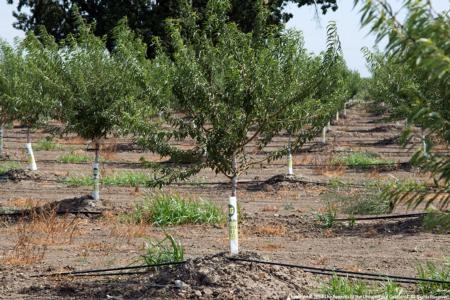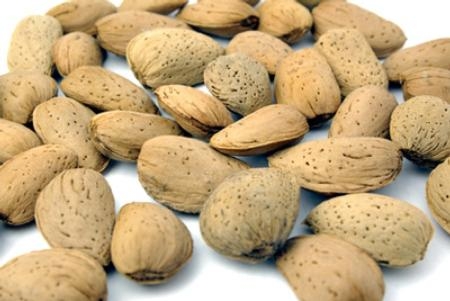Posts Tagged: Patrick Brown
UC scientists share national award for water conservation project
California's ongoing drought has made it even more critical for growers to get the most crop per drop of water used. Scientists from UC Division of Agriculture and Natural Resources and UC Davis and other land-grant universities were recently honored by USDA's National Institute of Food and Agriculture and the Association of Public and Land-Grant Universities for their years of research to help farmers better use microirrigation systems to sustainably irrigate their land.
The 2014 Experiment Station Section Excellence in Multistate Research Award presented by the Experiment Station Committee on Organization and Policy on Nov. 2 recognizes the universities' exceptional collaboration on a multistate research project.
Patrick Brown, professor in the Department of Plant Sciences at UC Davis, Jan Hopmans, professor in the Department of Land, Air and Water Resources at UC Davis, Larry Schwankl, UC Cooperative Extension specialist emeritus, and Ken Shackel, professor in the Department of Plant Sciences at UC Davis, are the UC researchers participating in the project “Microirrigation for Sustainable Water Use.”
"The Multistate Research Program is one of the best kept secrets of the land-grant university system, and this award recognizes outstanding interdependent efforts of researchers and extension specialists that have come together to tackle a priority issue that no one institution can address on their own,” said H. Michael Harrington, executive director of the Western Association of Agricultural Experiment Station Directors. “This microirrigation project was selected out of more than 300 multistate projects because, since 1972, the group has made major advances in sustainable agriculture and water conservation.”
Using more precise irrigation management, California growers have increased water use efficiency on processing tomatoes by 54 percent and on almonds by 33 percent since 1990.
Conventional irrigation systems that apply high volumes of water over wide areas can lose a lot of water through runoff, wind, or evaporation. As a result, conventional irrigation systems often over water or under water plants. Instead, microirrigation, or drip, systems use special timers, sensors, and a network of narrow tubes to deliver the right amount of water at the right time.
In the last five years, the group's research has led to new microirrigation equipment and tools that are easier to install, more durable, and more precise. These advances, along with engagement with farmers, have encouraged adoption of microirrigation systems, which has led to significant economic and environmental impacts.
“As director of USDA-NIFA, my goal is to ensure the science we invest in leads to solutions to today's most pressing challenges,” said Sonny Ramaswamy. “One of those challenges is finding ways to feed the growing population while minimally impacting the environment. A safe, reliable supply of water is inextricably linked to food security. The five-fold increase in irrigated acres that took place during the 20th century cannot be repeated in the 21st century — there isn't the space. Instead, we must increase efficiency of the irrigated farmland we have, and that is what this project is doing.”
In addition to UC, other participating land-grant institutions include Auburn University, University of Arizona, Colorado State University, University of Florida, University of Hawaii, University of Idaho, Iowa State University, Kansas State University, Mississippi State University, University of Nebraska, New Mexico State University, Cornell University, Oregon State University, University of Puerto Rico, Texas A&M AgriLife Research, University of the Virgin Islands, Washington State University, and University of Wyoming. The universities collaborated with the USDA's Natural Resources Conservation Service and Agricultural Research Service.
The award was presented by ESCOP chair Bob Shulstad and Ramaswamy at the Association of Public and Land-Grant Universities annual meeting in Orlando, Fla.
The project's name will be added to a plaque at the USDA Waterfront Centre in Washington, D.C., and the group will receive $15,000 to support their ongoing work. The group's continued efforts are more critical than ever as the U.S. continues to experience extreme droughts that threaten water supplies and crops that depend on irrigation.
These efforts are supported, in part, through USDA-NIFA by the Multistate Research Fund, established in 1998 by the Agricultural Research, Extension, and Education Reform Act (an amendment to the Hatch Act of 1888) to encourage and enhance multistate, multidisciplinary agricultural research on critical issues. Additional funds were provided by contracts and grants to participating scientists. For more information about the microirrigation project, visit http://www.cropinfo.net/MI.
Almonds become California's second-most valuable commodity
When California publishes its crop report in November, there will be a significant change in the ranking order of the state’s top agricultural commodities. In 2011, for the first time ever, the value of the California almond crop surpassed the state’s iconic grape industry to move into second place, behind dairy.
California almonds are on a roll. In the last 20 years, scientific discovery and grower ingenuity have nearly doubled almond per-acre productivity. A good yield in the 1980s was 1,400 pounds per acre. The average yield for 2011 was 2,670 pounds of shelled almonds per acre.
Forty years ago, California farmers produced less than 100 million pounds of almonds on about 200,000 acres of almond orchards. Mechanization, improved irrigation efficiency, advances in insect and disease management, pruning research and fertilization studies have fueled explosive growth in the industry. Farmers in California’s Central Valley now tend 760,000 acres of almond trees, producing about 2 billion pounds of shelled nuts a year. The crop, which represents 100 percent of U.S. almond production and 75 to 80 percent of world production, was valued in 2011 at $3.87 billion, surpassing table, wine and raisin grapes, which were valued at $3.86 billion.
“Even with this record production, we have more demand than we have supply,” said Bob Curtis of the Almond Board. “The driver behind that is nutrition studies that show almonds are a healthy food and snack.”
A tremendous amount of UC research is behind the California almond success story, said Bruce Lampinen, UC Cooperative Extension specialist in the Department of Plant Sciences at UC Davis, an expert in almond canopy management.
“Higher density plantings of almonds and a trend towards less pruning, and improved water management have led to much higher yields,” Lampinen said.
Many almond growers have replaced flood irrigation with micro-sprinkler or drip irrigation, said Larry Schwankl, UC Cooperative Extension specialist in the Department of Land, Air and Water Resources at UC Davis. These irrigation systems increase the precision of water and fertilizer application. Over the years, UC Cooperative Extension advisors and specialists established demonstrations of micro-sprinkler and drip systems in many parts of the Central Valley and reached out to farmers to show how they could be managed to optimize production.
“Twenty years ago, we simply guessed at the amount of water that the trees needed and we applied it on a calendar basis,” said Joe MacIlvaine, president of Paramount Farming Company in Kern County, one of the state’s largest growers of almonds, pistachios and pomegranates. “Today, we are delivering water and nutrients directly to the root zones when they are needed.”
Two decades ago, a granular form of nitrogen fertilizer was generally applied to almond orchards in the fall to allow winter rain and irrigation to move it into the soil for use by the trees in spring and early summer. Nitrogen use efficiency was believed to be about 40 percent. Now, nitrogen fertilizer is applied through the irrigation system during the growing season, when the tree needs it.
“Today, our nitrogen use efficiency can be as high as 85 percent,” said Blake Sanden, UCCE advisor in Kern County, an irrigation expert. He and Patrick Brown, professor in the Department of Plant Sciences at UC Davis, have conducted nitrogen trials in almonds with Paramount Farming.
“When you increase the conversion of applied nitrogen fertilizer to higher crop yield, there is significantly less potential for nitrogen to leach below the rootzone and contaminate groundwater,” Sanden said. “But each field is unique and requires site-specific management to achieve these high levels of efficiency.”
Another area where UC research has led to significant crop yield growth is in canopy management and tree spacing. Research by Mario Viveros, UCCE advisor emeritus in Kern County, and other scientists showed that a tendency among growers to over prune was taking a toll at harvest time.
“A lot of farmers who are now growing almonds had experience with fresh fruits, where you do need to prune to get light on the fruit for good color. In almonds more canopy generally means more yield,” Lampinen said. “Today, most almond growers only prune when branches are growing in the way of tractors or other equipment.”
UC research also found that orchards planted with traditional wide spacing between the trees weren’t making the most efficient use of sunlight on the farms. Older orchards had 60 to 70 trees per acre. Today, almond orchards are planted at an average density of about 110 trees per acre based on results of UC research.
However, studies have also shown that crowding still more trees into orchards triggers diminishing returns. In almond production, the nuts are shaken from the trees to dry on the ground before they are harvested.
“If the orchard floor becomes too shaded by trees planted too densely, the orchard floor temperature and humidity become optimal for growth of pathogens that could become a food safety problem,” Lampinen said. “You want enough sunlight to hit the orchard floor to reduce potential pathogens, like salmonella.”
MacIlvaine acknowledged the role of UC Cooperative Extension in helping the almond industry achieve the production milestone in 2011.
“The University of California has been a wonderful partner in improving our farming practices,” he said. “The whole system is not only more efficient, but more sustainable at the same time.”
Hear more of MacIlvaine's comments in the video posted below:


